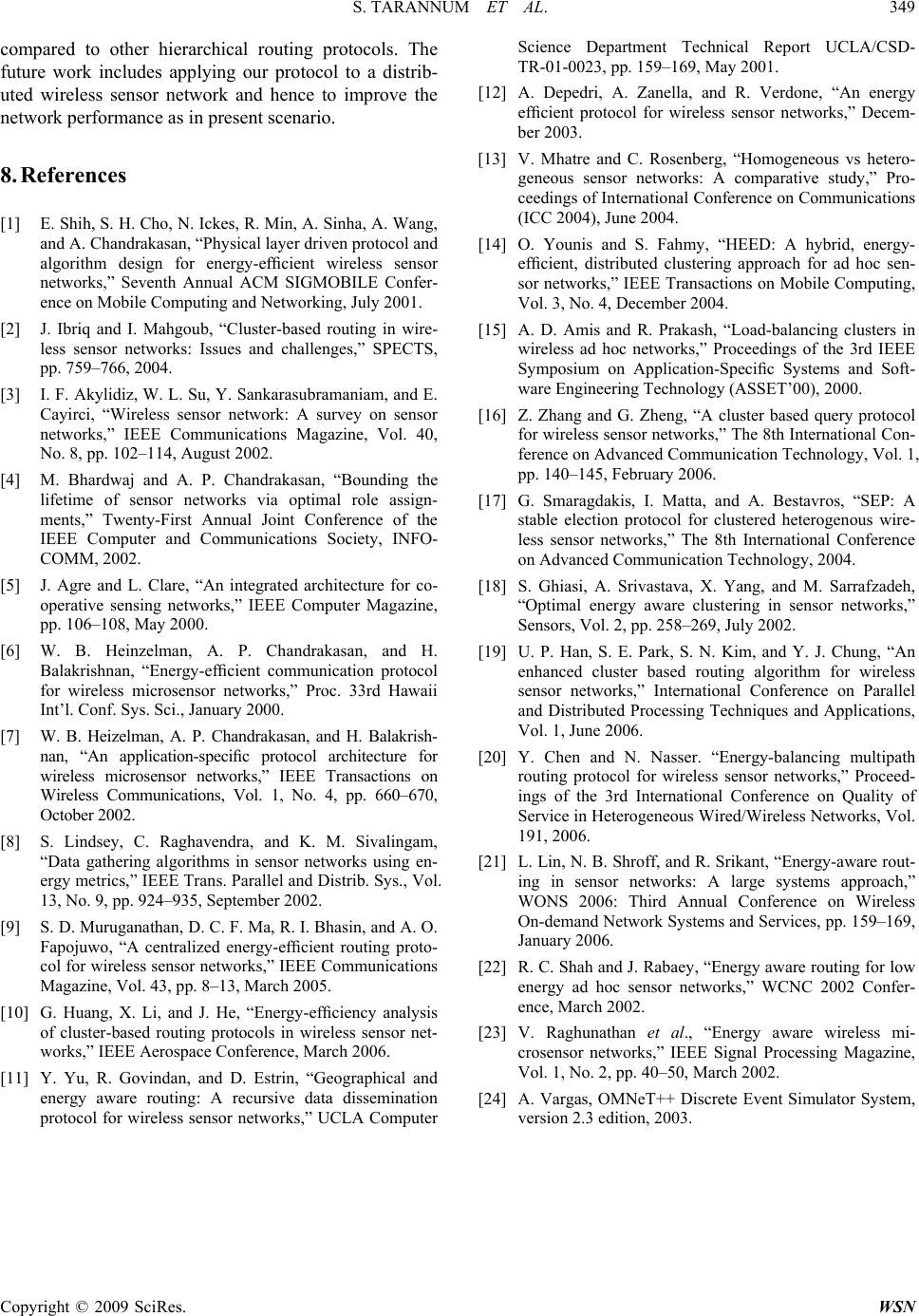
S. TARANNUM ET AL. 349
Copyright © 2009 SciRes. WSN
compared to other hierarchical routing protocols. The
future work includes applying our protocol to a distrib-
uted wireless sensor network and hence to improve the
network performance as in present scenario.
8. References
[1] E. Shih, S. H. Cho, N. Ickes, R. Min, A. Sinha, A. Wang,
and A. Chandrakasan, “Physical layer driven protocol and
algorithm design for energy-efficient wireless sensor
networks,” Seventh Annual ACM SIGMOBILE Confer-
ence on Mobile Computing and Networking, July 2001.
[2] J. Ibriq and I. Mahgoub, “Cluster-based routing in wire-
less sensor networks: Issues and challenges,” SPECTS,
pp. 759–766, 2004.
[3] I. F. Akylidiz, W. L. Su, Y. Sankarasubramaniam, and E.
Cayirci, “Wireless sensor network: A survey on sensor
networks,” IEEE Communications Magazine, Vol. 40,
No. 8, pp. 102–114, August 2002.
[4] M. Bhardwaj and A. P. Chandrakasan, “Bounding the
lifetime of sensor networks via optimal role assign-
ments,” Twenty-First Annual Joint Conference of the
IEEE Computer and Communications Society, INFO-
COMM, 2002.
[5] J. Agre and L. Clare, “An integrated architecture for co-
operative sensing networks,” IEEE Computer Magazine,
pp. 106–108, May 2000.
[6] W. B. Heinzelman, A. P. Chandrakasan, and H.
Balakrishnan, “Energy-efficient communication protocol
for wireless microsensor networks,” Proc. 33rd Hawaii
Int’l. Conf. Sys. Sci., January 2000.
[7] W. B. Heizelman, A. P. Chandrakasan, and H. Balakrish-
nan, “An application-specific protocol architecture for
wireless microsensor networks,” IEEE Transactions on
Wireless Communications, Vol. 1, No. 4, pp. 660–670,
October 2002.
[8] S. Lindsey, C. Raghavendra, and K. M. Sivalingam,
“Data gathering algorithms in sensor networks using en-
ergy metrics,” IEEE Trans. Parallel and Distrib. Sys., Vol.
13, No. 9, pp. 924–935, September 2002.
[9] S. D. Muruganathan, D. C. F. Ma, R. I. Bhasin, and A. O.
Fapojuwo, “A centralized energy-efficient routing proto-
col for wireless sensor networks,” IEEE Communications
Magazine, Vol. 43, pp. 8–13, March 2005.
[10] G. Huang, X. Li, and J. He, “Energy-efficiency analysis
of cluster-based routing protocols in wireless sensor net-
works,” IEEE Aerospace Conference, March 2006.
[11] Y. Yu, R. Govindan, and D. Estrin, “Geographical and
energy aware routing: A recursive data dissemination
protocol for wireless sensor networks,” UCLA Computer
Science Department Technical Report UCLA/CSD-
TR-01-0023, pp. 159–169, May 2001.
[12] A. Depedri, A. Zanella, and R. Verdone, “An energy
efficient protocol for wireless sensor networks,” Decem-
ber 2003.
[13] V. Mhatre and C. Rosenberg, “Homogeneous vs hetero-
geneous sensor networks: A comparative study,” Pro-
ceedings of International Conference on Communications
(ICC 2004), June 2004.
[14] O. Younis and S. Fahmy, “HEED: A hybrid, energy-
efficient, distributed clustering approach for ad hoc sen-
sor networks,” IEEE Transactions on Mobile Computing,
Vol. 3, No. 4, December 2004.
[15] A. D. Amis and R. Prakash, “Load-balancing clusters in
wireless ad hoc networks,” Proceedings of the 3rd IEEE
Symposium on Application-Specific Systems and Soft-
ware Engineering Technology (ASSET’00), 2000.
[16] Z. Zhang and G. Zheng, “A cluster based query protocol
for wireless sensor networks,” The 8th International Con-
ference on Advanced Communication Technology, Vol. 1,
pp. 140–145, February 2006.
[17] G. Smaragdakis, I. Matta, and A. Bestavros, “SEP: A
stable election protocol for clustered heterogenous wire-
less sensor networks,” The 8th International Conference
on Advanced Communication Technology, 2004.
[18] S. Ghiasi, A. Srivastava, X. Yang, and M. Sarrafzadeh,
“Optimal energy aware clustering in sensor networks,”
Sensors, Vol. 2, pp. 258–269, July 2002.
[19] U. P. Han, S. E. Park, S. N. Kim, and Y. J. Chung, “An
enhanced cluster based routing algorithm for wireless
sensor networks,” International Conference on Parallel
and Distributed Processing Techniques and Applications,
Vol. 1, June 2006.
[20] Y. Chen and N. Nasser. “Energy-balancing multipath
routing protocol for wireless sensor networks,” Proceed-
ings of the 3rd International Conference on Quality of
Service in Heterogeneous Wired/Wireless Networks, Vol.
191, 2006.
[21] L. Lin, N. B. Shroff, and R. Srikant, “Energy-aware rout-
ing in sensor networks: A large systems approach,”
WONS 2006: Third Annual Conference on Wireless
On-demand Network Systems and Services, pp. 159–169,
January 2006.
[22] R. C. Shah and J. Rabaey, “Energy aware routing for low
energy ad hoc sensor networks,” WCNC 2002 Confer-
ence, March 2002.
[23] V. Raghunathan et al., “Energy aware wireless mi-
crosensor networks,” IEEE Signal Processing Magazine,
Vol. 1, No. 2, pp. 40–50, March 2002.
[24] A. Vargas, OMNeT++ Discrete Event Simulator System,
version 2.3 edition, 2003.